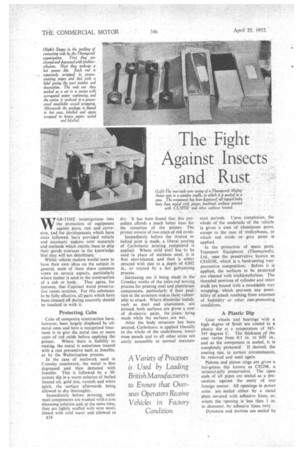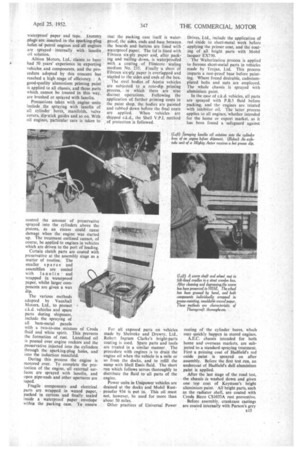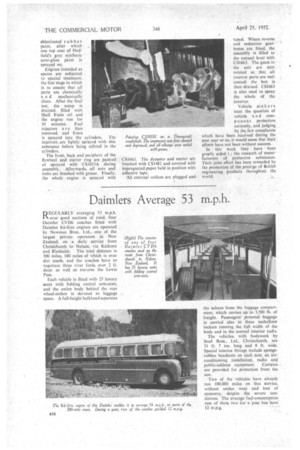• The Fight Against insects and Rust
Page 96

Page 97

Page 98

If you've noticed an error in this article please click here to report it so we can fix it.
(Left) The rear-axle arm casing of a Thormrcroft Mighty Antar seen in a wooden cradle, in which it is packed in a case. The component has been degreased, all tapped holes have been sealed with grease, machined surfaces painted
with CS.1033E arid other surfaces treated.
WAR-TIME investigations into the protection of equipment against pests, rust and corrosion, and the developments which have since followed, have provided vehicle and acceSsory makers with materials and methods which enable them to ship their goods overseas in the knowledge 'that they will not deteriorate.. •.
Whilst vehicle makers would seem to have their own ideas on the subject in general, most of them share common views on certain aspects, particularly where timber is used in the construction of a cab or body. They agree, for instance, that Cuprinol wood preservative resists termites. For this substance to be fully effective, all parts which have been cleaned off during assembly should be touched in with it.
Protecting Cabs
Cabs of composite construction have, however, been largely displaced by allmetal ones and here a recognized treatment is to give the metal one or more coats of red oxide before applying the primer. Where there is liability to rusting, the metal is sometimes treated with a rust preventive such as Jenolite, or by the Walterization process.
In the case of steelwork used in Crossley coachwork, the metal is first degreased and then derusted with Jenolite. This is followed by a 30minute dip in a warm solution of boiled linseed oil, gold size, varnish and white spirit, the surface afterwards being allowed to dry thoroughly.
Immediately before priming, mildsteel components are washed with a zinc cleansing solution and, at the same time, They are lightly scuffed with wire wool, rinsed with cold water and allowed to
E.14
dry. It has been found that this procedure affords a much better base for the reception of the primer. The primer consist of two coats of red oxide.
Immediately before the riveted or bolted joint is made, a liberal coating of Carbolastic jointing compound is applied. Where mild steel has to be used in place of stainless steel, it is first shot-blasted, and then is either sprayed with zinc to a depth of 0.002 in.. or treated by a hot galvanizing process.
_Increasing use is being made in the Crossley works of the infra-red stoving process for priming steel and aluminium components, particularly if their position in the structure makes them vulnerable to attack. Where dissimilar metals, such as steel and aluminium, are jointed, both surfaces are given a coat of di-electric paint, the joints• being made while the surfaces are wet.
After the body structure has been erected, Carbolastic is applied liberally to the whole of the underframe, lower truss panels and to all other areas not easily accessible at normal mainten ance periods. Upon completion, the whole of the underside of the vehicleis given a coat of aluminium paint, except in the case of trolleybuses, to which red oxide or grey paint is applied.
In the protection of spare parts, Transport Equipment (Thomycroft), Ltd., uses the preservative known as CS1033E, which is a hard-setting rustpreventive composition. Before it is applied, the surfaces to be protected are cleaned with trichlorethylene. The threaded portions of cylinder and other studs are bound with a mouldable wax wrapping, which prevents any possibility of attack resulting from extremes of humidity or other rust-promoting conditions.
A Plastic Dip
Gear wheels and bearings with a high degree of finish are coated in a plastic dip at a temperature of 185195 disgrees C. The thickness of the coat varies from 0.1 in. to 0.05 in., and as the component is sealed, it is completely protected. If desired, the coating can, in certain circumstances, be removed and used again.
Pistons and piston rings are given a hot-grease dip known as CS2296, a mineral-jelly preservative. The open ends of all pipes are sealed as a precaution against the entry of any foreign matter. All openings in power units are sealed either by a metal plate covered with adhesive linen, or, where the opening is less than 1 in. in diameter, by adhesive linen. only .
Dynamos and starters are sealed by waterproof paper and tape. Dummy plugs are inserted in the sparking-plug holes of petrol engines and all engines are sprayed internally with lanolin oil solution.
Albion Motors, Ltd., claims to have had 50 years' experience in exporting vehicles and components, and the procedure adopted by this concern has reached a high stage of efficiency. A good-quality aluminium priming paint is applied to all chassis, and those parts which cannot be treated in this way, are brushed or sprayed with lanolin.
Precautions taken with engine units include the spraying with lanolin of all cylinder bores, manifolds, valve covers, dip-stick guides and so on. With oil engines, particular care is taken to control the amount of preservative sprayed into the cylinders above the pistons, as an excess could cause damage when the engine was started up. The treatment outlined cannot, of course, be applied to engines in vehicles which are driven to the port of loading.
Certain clutch parts are coated with preservative at the assembly stage as a matter of routine. The smaller spares and assemblies are coated with lanolin and wrapped in waterproof paper, whilst larger components are given a wax dip.
The various methods adopted by Vauxhall Motors, Ltd., to protect c.k.d. vehicles and spare parts during shipment, include the spraying of all bare-metal panels with a two-hi-one mixture of Croda fluid and white spirit. This prevents the formation of Just. Lanolized oil is poured over engine rockers and the preservative injected into the cylinders through the sparking-plug holes, and into the induction manifold.
During this process the engine is motored over. To complete the protection of the engine, all external surfaces are sprayed with lanolin, and open pipe-ends and other apertures are taped.
Fragile components and electrical parts are wrapped in waxed paper, packed in cartons and finally sealed inside a waterproof paper envelope within the packing case. To ensure that the packing case itself is waterproof, the sides, ends and base between the boards and battens are lined with waterproof paper. The lid is lined with Fibreen six-ply paper and, after packing and nailing • down, is waterproofed with a coating of Flintcote s'ealing medium No. 235. Finally a sheet of Fibreen six-ply paper is overlapped and stapled to the sides and ends of the box.
The steel bodies of Austin vehicles are subjected to a roto-dip priming process, in which there are nine distinct operations. Following the application of further priming coats in the paint shop, the bodies are painted and rubbed clown before the final coats are applied. When vehicles are shipped c.k.d., the Shell V.P.I. method of protection is followed.
For all exposed parts on vehicles made by Shelvoke and Drewry, Ltd., Robert Ingram Clarke's bright-parts coating is used. Spare parts and toolsare treated in a similar manner. The procedure with engines is to drain the engine oil when the vehicle is a mile or so from the docks, and to refill the sump with Shell Ensis fluid. The short run which follows serves thoroughly to distribute the fluid to all parts of the engine.
Power units in Unipower vehicles are drained at the docks and Mobil Rustproofer 934 is put in. This oil must not, however, be used for more than about 50 miles.
Other practices of Universal Power Drives, Ltd., include the application of red oxide to sheet-metal work before applying the primer coat, and the Coating of all bright parts with Mobil lacquer EX730.
The Walterization process is applied to ferrous sheet-metal parts in vehicles made by Trojan, Ltd. This process imparts a rust-proof base before painting. Where found desirable, cadmiumplated bolts and nuts are employed. The whole chassis is sprayed with aluminium paint.
In the case of c.k.d. vehicles, all parts are sprayed with P.B.5 fluid before packing, and the engines are treated with inhibitor oil. The latter process applies to all engines, rwhethcr intended for the home or export market, as it has been found a safeguard against rusting of the cylinder bores, which may quickly happen in stored engines.
A.E.C. chassis intended for both home and overseas markets, are subjected to a standard spraying treatment. First a priming coat of Hadfield's red oxide paint is sprayed on after assembly. Before the first test run, an undercoat of Hadfield's dull aluminium paint is applied.
After the last stage of the road test, the chassis is washed down and given one top coat of Keystone's bright aluminium paint. All bright parts, such as the radiator shell, are coated with Croda Bicro CS1033A rust preventive.
Before assembly, crankcase castings are coated internally with Parson's grey chlorinated rubber paint, after which one top coat of Hadfield's grey synthetic semi-gloss paint is sprayed on.
Engines intended as spares are subjected to special treatment, the first stage in which is to ensure that all parts are chemically a n d mechanically clean. After the final test, the sump is drained, filled with Shell Ensis oil and the engine run for 10 minutes. Fuel injectors are then removed, and Ensis is sprayed into the cylinders. The injectors, are lightly sprayed with this substance before being refined in the cylinders.
The front, back and periphery of the flywheel and starter ring are painted or sprayed with CSI033A during assembly. Afterwards. all nuts and bolts are brushed with grease. Finally, the whole engine is sprayed with CSI663. The dynamo and starter are brushed with CS1482 and covered with impregnated paper held in position with adhesive tape.
All external orifices are plugged and taped. Where reverse and reduction gearboxes are fitted, the assembly is filled to the normal level with CS1663. The gears in the unit are next rotated so that all interior parts are well coated; the box is then drained. CSI663 is also used to spray the whole of the exterior.
Vehicle makers treat the question of vehicle a n d cornp o ne n t protection seriously, and judging by the few complaints which have been received during the past year or so, it would seem that their efforts have not been without success..
In this work they have been greadraided U the research of manufacturers of protective substances. Their joint effort has been rewarded by the promotion of the prestige of British engineering products throughout the world.




























































































































































































































